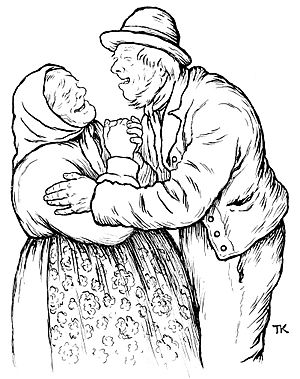Gudbrand on the Hill-side facts for kids
Quick facts for kids Gudbrand On the Hillside |
|
|---|---|

Gudbrand (right) and his wife
|
|
| Folk tale | |
| Name | Gudbrand On the Hillside |
| Also known as | Gudbrand i Lia |
| Data | |
| Aarne–Thompson grouping | 1415, Trading Away One's Fortune |
| Country | Norway |
| Published in | Norske Folkeeventyr |
Gudbrand on the Hillside is a famous Norwegian folk tale. It teaches us about staying positive no matter what happens. This story is found in many collections, like Best-Loved Folktales of the World (1982).
It was first collected by Peter Christen Asbjørnsen and Jørgen Engebretsen Moe. They included it in their book Norske Folkeeventyr between 1853 and 1858. This tale shares messages about being optimistic and happy in marriage.
The famous writer Hans Christian Andersen also wrote his own version. It's called "What the Old Man does is always Right." This version appeared in his book Nye Eventyr og Historier in 1861.
Contents
The Story of Gudbrand
This folk tale is about a man named Gudbrand and his wife. They live happily together on a hillside in Norway. One day, they decide to sell one of their two cows. Gudbrand heads off to town to do this.
Gudbrand's Trading Journey
When Gudbrand arrives in town, he can't sell his cow. But he's not worried, so he starts heading home. On his way, he meets a man with a horse. Gudbrand decides to trade his cow for the horse.
Further along, he meets another man who has a pig. Gudbrand trades his new horse for the pig. Then, he comes across a man with a goat. He trades the pig for the goat.
Next, Gudbrand trades his goat for a sheep. After that, he trades the sheep for a goose. Finally, he trades the goose for a rooster.
Empty-Handed but Happy
Gudbrand soon realizes he is very hungry. He decides to sell his rooster to buy some food. This leaves him with nothing to bring home. Still, Gudbrand feels good about his choices.
He stops at a neighbor's house to rest for the night. Gudbrand tells his neighbor all about his trades. The neighbor is surprised and says his own wife would be very upset.
Gudbrand, however, is sure his wife will understand. He tells his neighbor that they always get along well. He believes she will agree with all his decisions.
The Bet with the Neighbor
Gudbrand makes a bet with his neighbor. He bets one hundred thalers (an old type of money). The bet is that his wife will not be displeased with his choices. The neighbor accepts the bet.
The next day, Gudbrand and his neighbor go to Gudbrand's home. The neighbor hides behind the door to listen. Gudbrand greets his wife and explains everything that happened.
Gudbrand's Wife's Reaction
As Gudbrand tells his story, his wife finds something positive in every trade. When he explains selling the rooster for food, she is even happier. She exclaims, "Now God be praised that you did so!"
She continues, "Whatever you do, you do it always just after my own heart. Heaven be thanked that I have got you safe back again; you who do everything so well that I want neither rooster nor goose; neither pigs nor kine."
Gudbrand wins the bet! His neighbor is amazed by his wife's positive attitude.
Andersen's Version of the Tale
Hans Christian Andersen's story, "What the Old Man does is always Right," is similar. In his version, the man starts with a horse instead of a cow. He ends up with a bag of rotten apples instead of nothing. Also, his bet is with two traveling Englishmen, not a neighbor. The main idea of the story, however, remains the same.
Meet the Characters
- Gudbrand: He is a kind husband who makes quick decisions. He always stays positive, no matter what life throws at him.
- Gudbrand's Wife: She is very optimistic and supports her husband completely. She always finds the good side of every situation.
- The Neighbor: He shows how most people might react to Gudbrand's choices. He also represents how other wives might respond to such news.

